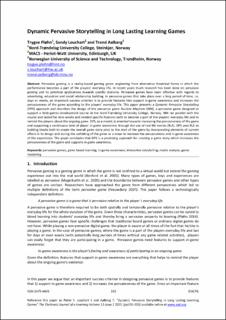Dynamic Pervasive Storytelling in Long Lasting Learning Games
Peer reviewed, Journal article
Published version

Åpne
Permanent lenke
https://hdl.handle.net/11250/2657480Utgivelsesdato
2015Metadata
Vis full innførselSamlinger
Originalversjon
Pløhn, T., Louchart, S. & Aalberg, T. (2015). Dynamic pervasive storytelling in long lasting learning games. Electronic Journal of e-Learning, 13(3), 193-205.Sammendrag
Pervasive gaming is a reality‑based gaming genre originating from alternative theatrical forms in which the performance becomes a part of the players⠒ everyday life. In recent years much research has been done on pervasive gaming (Benford et al. 2005, Cheok et al. 2006, Jegers and Wiberg 2006) and its potential applications towards specific domains. Pervasive games have been effective with regards to advertising (VG 2009), education (Pløhn 2013) and social relationship building (Pløhn and Aalberg 2013). In pervasive games that take place over a long period of time, i.e. days or weeks, an important success criterion is to provide features that support in‑game awareness and increases the pervasiveness of the game according to the playe rs⠒ everyday life. However, given the nature of pervasive games, they also pose challenges when compared to more traditional gaming approaches, namely; 1) How can one make the game pervasive according to the players⠒ everyday life? and 2) How can on e support in‑game awareness?. This paper presents a Dynamic Pervasive Storytelling (DPS) approach and describes the design of the pervasive game Nuclear Mayhem (NM), a pervasive game designed to support a Web‑games development course at the Nord‑Trøn delag University College, Norway. NM ran parallel with the course and lasted for nine weeks and needed specific features both to become a part of the players⠒ everyday life and to remind the players about the ongoing game. DPS, as a model, is oriented t owards increasing the pervasiveness of the game and supporting a continuous level of player in‑game awareness through the use of real life events (RLE). DPS uses RLE as building blocks both to create the overall game story prior to the start of the game by incorporating elements of current affairs in its design and during the unfolding of the game as a mean to increase the pervasiveness and in‑game awareness of the experience. The paper concludes that DPS is a promising approach for creating a game stor y which increases the pervasiveness of the game and supports Keywords: Keywords: pervasive games, game based learning, in-game awareness, interactive storytelling, media analysis, game mastering Dynamic Pervasive Storytelling in Long Lasting Learning Games
